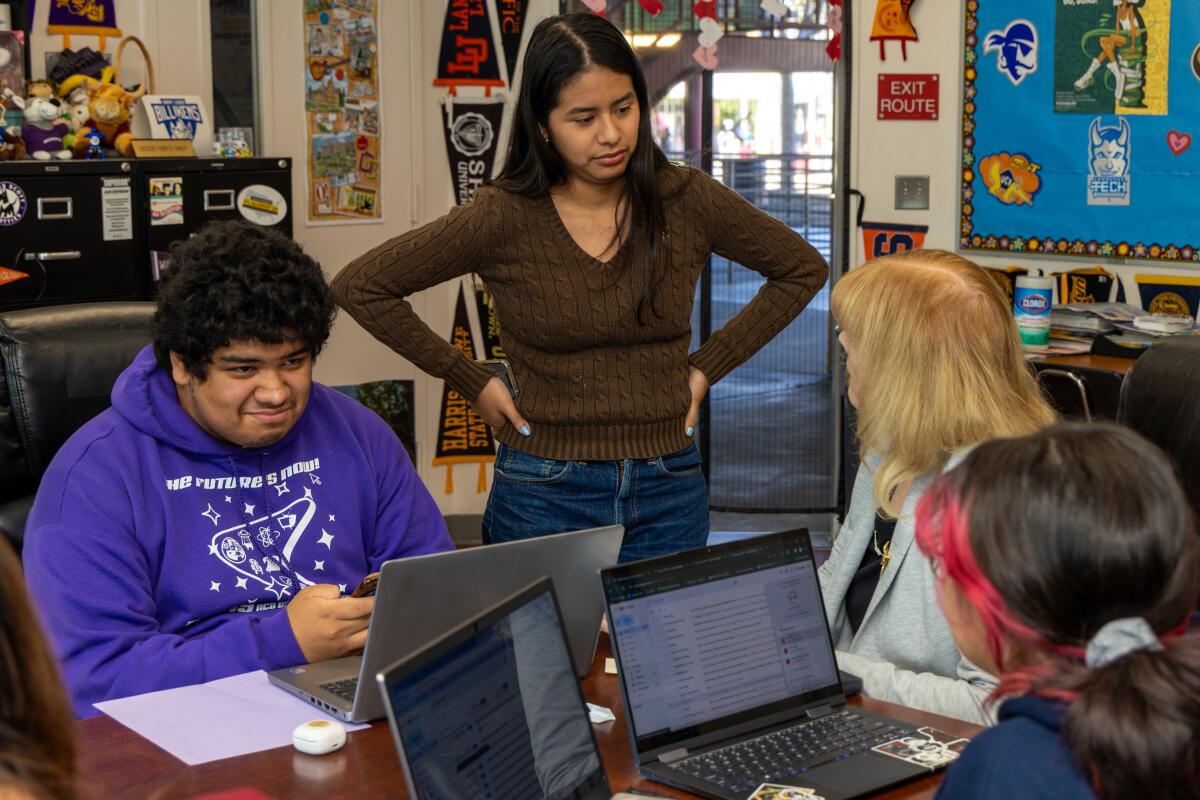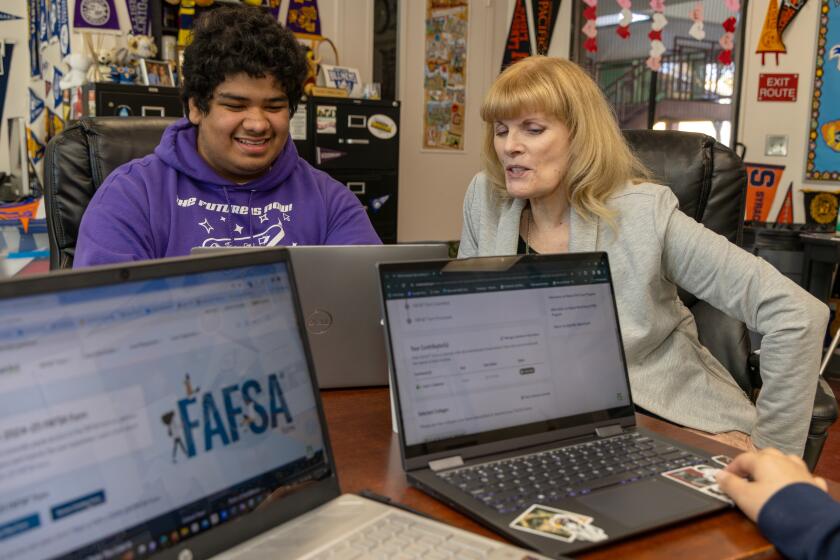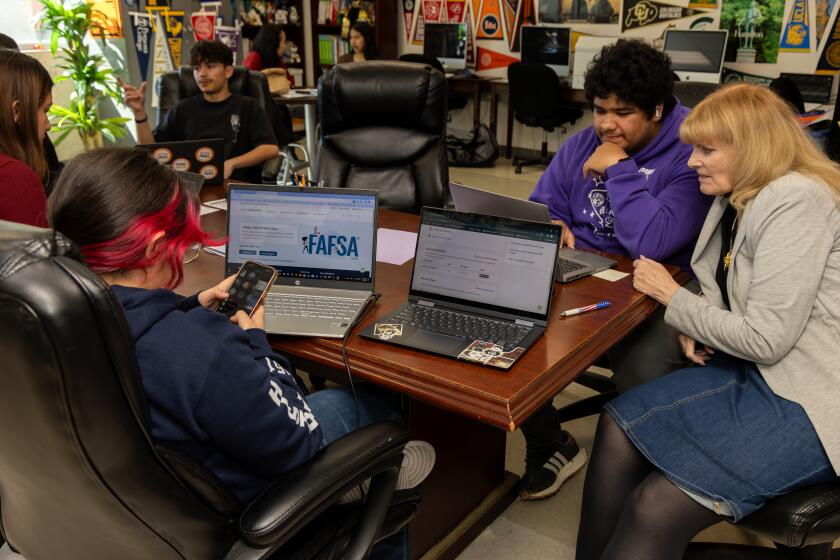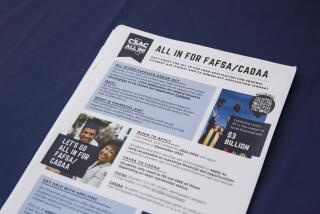College financial aid extension in the works for California students hurt by FAFSA mess

- Share via
California lawmakers are speedily moving forward toward approving a bill that would extend a key college financial aid deadline by a month to help students whose applications have been mired in problems at the federal level.
The deadline for Cal Grants and other state aid programs — that collectively dole out more than $2.3 billion — would be pushed back from April 2 to May 2 under legislation that would take effect immediately.
“Making our students’ dreams of achieving higher education more affordable and accessible is among the Legislature’s highest duties,” said Assemblymember Sabrina Cervantes (D-Riverside), who authored the version of the bill that passed Monday by a vote of 73 to 0.
The bill also must be passed by the state Senate — likely to happen later this week — and then would go to Gov. Gavin Newsom for his signature.
The legislation is one more attempt to ease what has become a long-running nightmare for students who depend on financial aid to attend college.
A chaotic rollout of a new federal financial aid form is roiling high schools and upending college admissions, impeding students from filling out the all-important FAFSA form.
This problem originated at the federal level, where the U.S. Department of Education was under orders from Congress to make the Free Application for Federal Student Aid, or FAFSA, simpler and more accessible. If more students could successfully complete the FAFSA, college would probably become more affordable for many additional families.
But the new system fell behind schedule and then filling out and processing applications exposed serious glitches. Officials said they were understaffed and underfunded for the project — compounding the delay in fixes and the shortage of online, phone and email help for students and families, especially when assistance was needed in another language, such as Spanish.
Particularly hard-pressed were low-income families with complicated personal situations, including those in which a parent or student lacked a Social Security number.
The irony is that the new FAFSA is supposed to make things easier and faster but has resulted in the opposite. Federal education officials are scrambling to help.
The department this month announced that it had corrected the system to allow the online form to work for families lacking one or more Social Security numbers, although some information would still have to be submitted manually. But some families still are having difficulties.
Parents without a Social Security number must send a separate email with photos of their identification documents, such as a passport or driver’s license from their former country of residence, to the Department of Education, said Heather Brown, a counselor at Hollywood High.
The students with the most complex applications are frequently less well situated to complete them than others in need of the aid, Brown said.
About 90% of students at Hollywood High School have low-income parents who may lack personal phones, computers or emails, Brown said. Many work multiple jobs and have difficulty gathering documents.
“The more process, the less access,” she said. “The irony of it all is that these parents are being processed out of giving the government information it already has.”
Some families have concerns over how information they submit could be used.
“You’re undocumented or under documented, you’re already scared of being discovered, you’re feeling nervous,” Brown said. “So I’m supposed to sit there and talk a parent into sending something very private like their personal documents to some generic email?”
College financial aid workers also are feeling the strain.
“The problem has put a lot of pressure on our staff because of the urgency to get financial aid offers on the streets,” said Jose Aguilar, executive director of financial aid for UC Riverside.
The bill moving forward does not affect issues at the federal level. But it will give students more time to fill out applications without being hurt at the state level — where much of a student’s financial aid will come from.
“Moving the Cal Grant deadline should help ease anxiety for students,” Aguilar said. “We will continue to ask students to submit the FAFSA as soon as possible in order for us to provide them with preliminary financial aid award estimates.”
A Cal Grant does not need to be paid back but applicants must apply using the FAFSA or California Dream Act Application by the deadline and meet all eligibility, financial and minimum grade-point-average requirements.
The grants help students attending University of California, California State University or state community colleges. Students attending private California universities and some career colleges or technical schools can also be eligible.
There are different kinds of Cal Grants, but students don’t have to figure that out. The application system does that for them. Grants range as high as $15,400 in a given year, with many factors determining the amount of aid available.
U.S. Department of Education officials said they have prioritized getting the system to work correctly and said they are making progress.
“We are putting all hands on deck and using every lever we have,” U.S. Secretary of Education Miguel Cardona said recently.
The message, however, was undermined by the revelation that a Department of Education inbox with 70,000 emails from applicants, containing essential information, had been untouched by department staffers as of early March.
People at all levels are trying to help. Cal State campuses have conducted workshops with local high schools — and also stepped up assistance for continuing students, who also were encountering unfamiliar hang-ups with their applications.
The proposed easing of the state deadline follows an earlier attempt to help at the state level.
In February, the University of California and California State University announced they would extend the May 1 deadline to May 15 for students to accept their admission offers for fall 2024.
The May 15 deadline applies to first-year students at all nine undergraduate UC campuses; CSU’s deadline is “no earlier” than May 15 for all 23 of its campuses.
But the current push to extend the deadline for state aid programs comes with a downstream cost. Students must make decisions about their future without knowing their financial aid packages — as colleges can’t prepare their offer until they receive processed FAFSA forms.
“They’re going to have to make really hard decisions that might not be informed by real data,” said Darcel Sanders, chief executive of GO Public Schools, a nonprofit that has helped immigrant families, among others, navigate the FAFSA process. “Like how many loans will they have to take out? What might the gap be if they have to work? Or parents taking on another job to help them close the gap?”
Times staff writer Teresa Watanabe contributed to this report.
More to Read
Sign up for Essential California
The most important California stories and recommendations in your inbox every morning.
You may occasionally receive promotional content from the Los Angeles Times.














